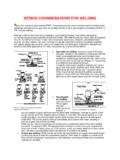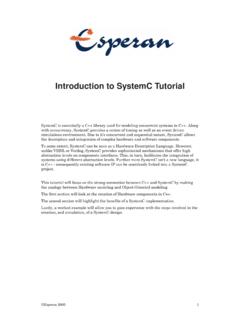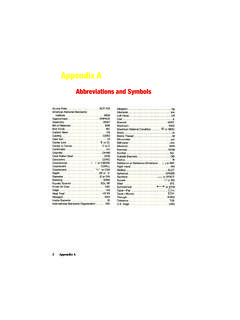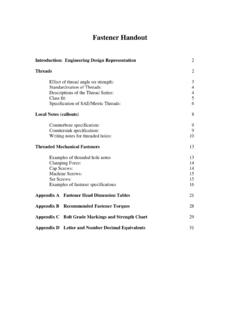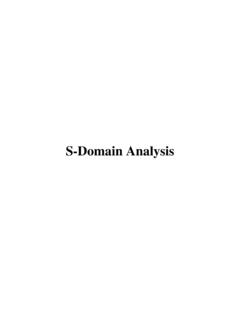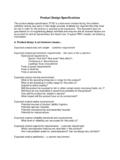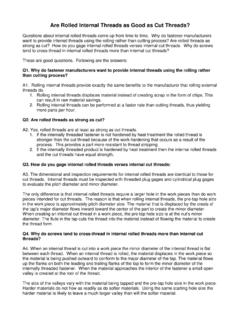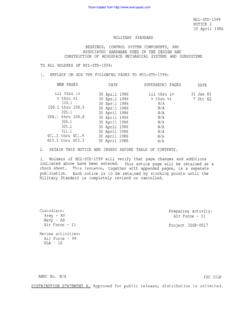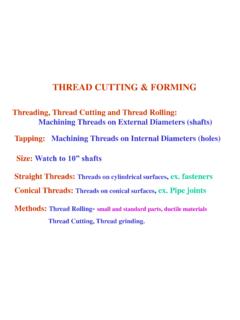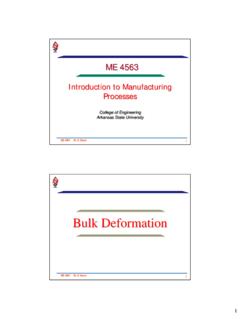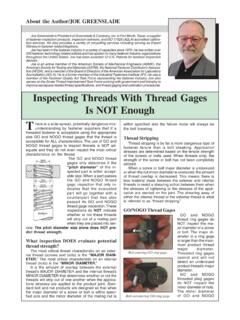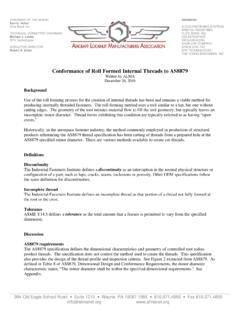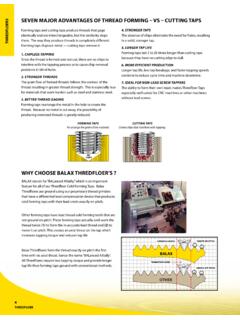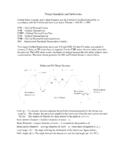Transcription of Common Mechanical Engineering Terms - CAE Users
1 Common Mechanical Engineering Terms Ball and Detent (n) A simple Mechanical arrangement used to hold a moving part in a temporarily fixed position relative to another part. The ball slides within a bored cylinder, against the pressure of a spring, which pushes the ball against the detent, a hole of smaller diameter than the ball. When the hole is in line with the cylinder, the ball falls partially into the hole under spring pressure, holding the parts at that position. Additional force will push the ball back into its cylinder, compressing the spring, and allowing the parts to move.
2 (also shown: detent pins) Bearing (ball, roller, and spherical shown ) (n) The part of a machine within which a rotating or sliding shaft is held. In some bearing types, balls or rollers are used between the bearing surfaces to reduce rolling friction. Bell crank (n) A pivoting double lever used to change the direction of applied motion. Boss (n) A cylindrical projection, as on a casting or a forging. Usually provides a contact surface around a hole. Broach (v)To finish the inside of a hole to a shape other than round, as in a keyway (n) The tool for the process, which has serrated edges and is pushed or pulled through the hole to produce the required shape.
3 Burnish (v) To smooth or polish by a rolling or sliding tool under pressure. Bushing (n) A smooth walled bearing (AKA a plain bearing). Also a tool guide in a jig or fixture. Cam (n) A Mechanical device consisting of an eccentric or multiply curved wheel mounted on a rotating shaft, used to produce variable or reciprocating motion in another engaged or contacted part (cam follower). Also Camshaft Casting (n) Any object made by pouring molten metal into a mold. Chamfer (n) A flat surface made by cutting off the edge or corner of a object (bevel) (v) the process of creating a chafer Clevis (n) A U-shaped piece with holes into which a link is inserted and through which a pin or bolt is run.
4 It is used as a fastening device which allows rotational motion. Collar (n) A cylindrical feature on a part fitted on a shaft used to prevent sliding (axial) movement. Collet (n) A cone-shaped sleeve used for holding circular or rodlike pieces in a lathe or other machine. Core (v) To form the hollow part of a casting, using a solid form placed in the mold (n) The solid form used in the coring process, often made of wood, sand, or metal. Mold with CORE Final Cast Manifold Counterbore (n) A cylindrical flat-bottomed hole, which enlarges the diameter of an existing pilot hole.
5 (v) The process used to create that feature. (the req d tool is shown) Countersink (n) A conical depression added to an existing hole to accommodate and the conic head of a fastener recessing it below the surface of a face. (v) The process used to create that feature. (the req d tool is shown) Coupling (n) A device used to connect two shafts together at their ends for the purpose of transmitting power. May be used to account for minor misalignment or for mitigating shock loads. Die (n) One of a pair of hardened metal plates or impressing or forming desired shape.
6 Also, a tool for cutting external threads. thread rolling Dies Face (v) To machine a flat surface perpendicular to the axis of rotation of a piece. Fillet (n) A rounded surface filling the internal angle between two intersection surfaces. Also Rounds Fit (n) The class of contact between two machined surfaces, based upon their respective specified size tolerances (clearance, transitional, interference) Fixture (n) A device used to hold a workpiece while manufacturing operations are performed upon that workpiece.
7 Flange (see bushing example) (n) A projecting rim or edge for fastening, stiffening or positioning. Gage (n) A device used for determining the accuracy of specified manufactured parts by direct Gage blocks (n) Precision machined steel blocks having two flat, parallel surfaces whose separation distance is fabricated to a guaranteed accuracy of a few millionths of an inch; Gear Hobbing (v) A special form of manufacturing that cuts gear tooth geometries.
8 It is the major industrial process for cutting involute form spur gears of. Geneva Cam (n) A device to turn constant rotational motion into intermittent rotational motion. Gusset (plate) (n) A triangular metal piece used to strengthen a joint. Hasp (n) A metal fastener with a slotted, hinged part that fits over a loop and is secured by a pin, bolt, or padlock Idler (n) A mechanism used to regulate the tension in belt or chain.
9 Or, a gear used between a driver and follower gear to maintain the direction of rotation. Jig (n) A special device used to guide a cutting tool (drill jig) or to hold material in the correct position for cutting or fitting together (as in welding or brazing) Idler Journal (n) The part of a shaft that rotates within a bearing Kerf (n) A channel or groove cut by a saw or other tool. Key (Woodruff key shown) (n) A small block or wedge inserted between a shaft and hub to prevent circumferential movement. Keyseat (n) A slot or groove cut in a shaft to fit a key.
10 A key rests in a keyseat. Keyway (n) A slot cut into a hub to fit a key. A key slides in a keyway. See Broach. Key/Keyway/Keyseat assembly (see above for individual definitions) Knurl (v) To roughen a turned surface, as in a handle or a knob. Lug (n) Projection on (typically) a cast or forged part to provide support or allow mounting or the attachment of another component. Neck (v) To cut a groove around a shaft, usually toward the end or at a change in diameter.
